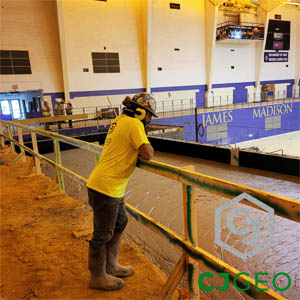Commercial & Industrial
-

Chemical Underpinning
The Job This chemical underpinning project is located outside of Pittsburgh, Pennsylvania at a ma...
-

Commercial Floor Void Fill
THE JOB This commercial floor void fill project is located in Manhattan. During a Local Law 11 in...
-

Port Shed Floor Stabilization
THE JOB This port shed floor stabilization project is located in Baltimore, Maryland. The 11″ thi...
-

Office Floor Settlement Repair
The Job This office floor settlement repair project is located near Norfolk, Virginia. The slab f...
-

Tunnel Abandonment – Boston
THE JOB A plumbing contractor hand tunneled 140LF of 4’x5′ tunnel under two apartment buildings n...
-

School Floor Leveling
The Job This school floor leveling project is located in Princeton, West Virginia. The Princeton ...
-

Sewer Collapse Sinkhole Repair
The Job This sewer collapse sinkhole repair project is located in central Virginia. When the oper...
-

Corporate HQ Stabilization
The Job Starting immediately after construction was completed, the slab on the grade floor within...
-

Multiplate Tunnel Grouting
The Job This multiplate tunnel grouting project is located in Asheville, North Carolina. During a...
-

Fire Station Floor Lifting
The Job This fire station floor lifting project is located about an hour east of Richmond, Virgin...
-

250000 Gallon Oil Tank Abandonment
The Job This oil tank abandonment project is located in the nation’s capitol, Washington, D...
-

Precast Lagging Wall Lateral Load Reduction
The Job This load reduction backfill work as associated with the replacement of Scaife Hall, at C...
-

Lightweight Stem Wall Backfill
The Job This lightweight stem wall backfill work is part of the construction of a new academic bu...
-

Sloped Pit Lightweight Backfill
The Job This sloped pit lightweight backfill project is located in Western Virginia, at James Mad...
-

25MGD Sinkhole Leak Grouting
The Job An underground minerals mine started to lose up to 8VF per day of mine due to water infil...
-

Dollar Store Floor Void Filling
The Job This floor void filling project is located about three hours west of Richmond, Virginia. ...
-

Hotel Basement Water Intrusion Grouting
The Job This basement water intrusion grouting project was at a hotel in Baltimore, Maryland. It ...
-

Lightweight Tank Foundation
The Job This lightweight tank foundation installation project is located in Baltimore, Maryland. ...
-

Power Station Pipe Abandonment
The Job This power station pipe abandonment project is between Richmond & Lynchburg, Virginia...
-

Utility Tunnel Abandonment
The Job This utility tunnel abandonment project is located in Wilmington, Delaware. Approximately...
-

Grain Silo Tunnel Backfilling
The Job This grain silo tunnel backfilling project is located in Tampa, Florida. As part of a red...
-

Hollow Abutment Filling
The Job This hollow abutment filling project is located in Buckland, Massachusetts. Buckland is a...
-

Lightweight Plaza Fill
The Job Lightweight plaza fill for a private age restricted high rise new build in Tysons Corner,...
-

Warehouse Floor Joint Stabilization
The Job This floor joint stabilization project is located in Ashland, Virginia. About two months ...
-

Industrial Basement Abandonment
The Job This industrial basement abandonment project is located in Southside, Virginia. As part o...
-

Norfolk polyurethane grouting
The Job This Norfolk polyurethane grouting project is located on a military base. The medical cli...
-

8′ CMP Joint Grouting
The Job A spec warehouse was planned for a vacant piece of land which had 1700LF of 8′ CMP ...
-

Nashville Basement Backfill
The Job Nashville Yards is a block-wide new build project in downtown Nashville, Tennessee. With ...
-

Savannah Tunnel Abandonment
The Job This Savannah tunnel abandonment job is part of the JW Marriott Plant Riverside conversio...
-

Steam Tunnel Lightweight Backfill
The Job This steam tunnel lightweight backfill project is located at Western Carolina University,...
-

Nashville Basement Abandonment
The Job This Nashville basement abandonment project is located along Church Street, in downtown N...
-

Pit Fill With Lightweight Flowable Fill
The Job An abandoned water treatment plant at a federal facility was being rehabilitated and brou...
-

Coke Gas Pipe Fill
The Job This coke gas pipe fill project is located in Middletown, Ohio, at Cleveland Cliff’...
-

North Carolina Compaction Grouting
The Job This North Carolina compaction grouting project is located at a military facility in east...
-

New Jersey Lightweight Fill
The Job This New Jersey lightweight fill project is located in Secaucus, New Jersey. It’s p...
-

New Jersey polyurethane grouting
The Job This New Jersey polyurethane grouting project is located in Creskill, New Jersey. As part...
-

Maryland compaction grouting
The Job This Maryland compaction grouting project is located on East West Highway, in Chevy Chase...
-

Stormwater Sinkhole Repair
The Job This stormwater sinkhole repair project is located at a data center near Dulles, Virginia...
-

Virginia Lightweight Fill
The Job This Virginia lightweight fill installation is located Norfolk, Virginia. The placement i...
-

Apartment Floor Lifting
The Job This apartment floor lifting project is on a military facility in Washington, DC. During ...
-

Virginia Polyurethane Grouting
The Job This Virginia polyurethane grouting project is located in Blacksburg, Virginia, at Virgin...
-

Michigan Polyurethane Grouting
The Job This Michigan polyurethane grouting project is located near Saginaw, Michigan. The work w...
-

Underground Storage Tank Fill
The Job This underground storage tank fill project by CJGeo is located at a food manufacturing fa...
-

Flooded Shaft Grouting
The Job This flooded shaft grouting project by CJGeo is located outside of Washington, DC at a da...
-

Yonkers Polyurethane Grouting
The Job This Yonkers polyurethane grouting project is located in Yonkers, New York. The project i...
-

North Carolina Polyurethane Grouting
The Job This North Carolina polyurethane grouting project is located at Elon University. It is pa...
-

Fairfax Polyurethane Grouting
The Job This Fairfax polyurethane grouting project is located at a commercial building used for m...
-

NYC Cellular Concrete
The Job This NYC cellular concrete project is located at the William McCray Playground in Manhatt...